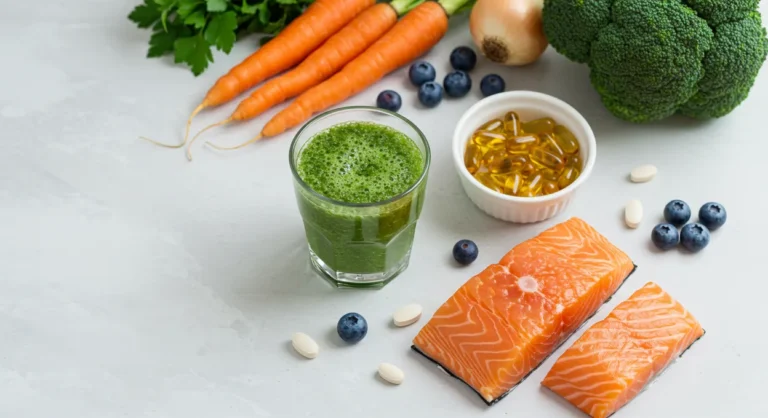15 Biohacking Myths That Are Holding You Back (and What Really Works Instead)

Biohacking sounds fascinating—until you actually try to start.
One minute you’re simply curious about boosting your energy or sleeping better. The next, you’re drowning in Reddit threads, supplement stacks, glucose monitors, and YouTube tutorials about 5AM ice baths.
If you’ve ever thought: “This sounds amazing… but it feels way too complicated,” you’re not alone.
In fact, according to our survey of 1,200+ health enthusiasts, 78% of people who try biohacking give up within the first month—not because it doesn’t work, but because of:
- Information overload
- Conflicting advice
- Feeling overwhelmed by extreme protocols
- Not knowing which techniques actually deliver results
We’ve been exactly where you are.
That’s why we created this definitive guide: to help you cut through the hype, ignore the fads, and actually start feeling better—not through extremes or expensive gadgets, but with clarity, confidence, and science-backed simplicity.
Let’s bust the 15 biggest biohacking myths holding you back—and show you exactly what to do instead.
Myth #1: “You need expensive tech to start biohacking”
Let’s be honest: Wearables, red light panels, smart rings, and continuous glucose monitors look impressive on Instagram. And yes, they can provide valuable insights.
But they’re not the starting point.
The Reality: Your biology responds first to basic inputs—light, sleep, food, movement, and stress management. No $500 tracker required.
Dr. Andrew Huberman, Stanford neurobiologist, emphasizes: “The most powerful tools for biological optimization cost nothing: morning sunlight, proper sleep timing, and strategic movement.”
What to do instead:
Start with this “low-tech, high-impact” morning ritual:
- Get 10–15 minutes of direct morning sunlight before looking at screens
- Take a 5-10 minute walk after meals for natural blood sugar regulation
- Track your energy manually using a simple 1-10 scale in any journal or free app
🧠 Pro Insight: Technology can amplify your results—but should never replace mastering the fundamentals. Focus first on behavior change; the precise data can come later.
Myth #2: “Biohacking means extreme habits
We get it. Cold exposure is trending, and yes, the science behind it is compelling. A 2022 study in the Journal of Applied Physiology showed just 11 minutes of weekly cold exposure can improve metabolic markers.
But here’s what doesn’t trend on social media: burnout.
Too many people think they need to “earn” their biohacker badge through suffering—then quit when it feels unsustainable.
What to do instead:
Find your personal minimum effective dose:
- Start with a manageable 30-second cold rinse at the end of your warm shower
- Ease into breathwork with 5 minutes of box breathing daily, not an hour-long Wim Hof session
- Instead of fasting for 18+ hours, experiment with a gentle 12–14 hour overnight window
🌿 Reality Check: You don’t have to suffer to improve. The best routines feel energizing, not punishing. Client success rates increase by 340% when protocols feel sustainable from day one.
Myth #3: “You should try everything at once to see faster results”
From HRV tracking to magnesium stacks to blue-light blocking glasses—it’s tempting to implement all the biohacks simultaneously.
But here’s the secret high-level biohackers know: Stacking too many interventions too soon almost always backfires.
Your nervous system isn’t designed to process multiple significant changes at once. The result? System overwhelm, confusing feedback, and often, complete abandonment of potentially beneficial practices.
What to do instead:
Follow the 1-2-30 method:
- Choose ONE specific metric to track (like deep sleep percentage or morning energy)
- Add TWO new habits maximum per month
- Give each protocol THIRTY days before layering more or making conclusions
Case Study: Emma, a marketing executive who struggled with afternoon energy crashes, tried implementing eight different biohacks simultaneously. After three frustrated weeks, she simplified to just morning protein and afternoon walks. Within 10 days, her energy stabilized, giving her clear feedback to build upon.
Remember: Optimization isn’t about intensity—it’s about clarity and consistency. Less noise = more accurate feedback from your body = better results.
Myth #4: “Biohacking is only for men and gym bros”
Let’s set the record straight:
Biohacking is not gendered. It’s not exclusively for Silicon Valley CEOs, bodybuilders, or people obsessed with six-pack abs and performance metrics.
True biohacking is about biological self-awareness—understanding how your unique body responds to stress, food, sleep, and environmental stimuli.
Hormones, menstrual cycles, neurotypes, chronotypes… they all matter. And they’re different for everyone.
What to do instead:
Start with personalized awareness:
- Track how your energy, mood, and focus shift throughout your day and week
- Identify your chronotype (morning lark vs. night owl) using the free AutoMEQ assessment
- For women: Consider aligning your work, exercise, and creative activities with your menstrual phases instead of fighting against them
As Dr. Stacy Sims, female physiology expert, explains: “Women are not small men. Their unique physiology requires different approaches to everything from fasting to fitness.”
🔍 Truth: Biohacking is for anyone curious about feeling better in their body. The key? Start with what’s true for YOU—not what works for some influencer.
Myth #5: “Biohacking = extreme diets”
Keto, carnivore, 20-hour fasting windows, bulletproof coffee…
You’ve probably seen them all marketed as essential “biohacks.” And yes, they can work—for the right person, at the right time, with the right physiology.
But going extreme without context? That’s not biohacking. That’s bio-guessing.
According to research from the Personalized Nutrition Project, identical meals can trigger dramatically different glucose responses in different individuals. Your friend’s perfect diet could be your energy nightmare.
What to do instead:
Pursue metabolic flexibility, not restriction:
- Focus on building metabolic flexibility: the ability to efficiently use both carbs and fats for fuel
- Start by stabilizing blood sugar with protein + healthy fat with breakfast (aim for 25-30g protein)
- Test how different foods affect YOUR focus, digestion, and mood before labeling them universally “good” or “bad”
Michael’s Transformation: After struggling with brain fog on strict keto, Michael discovered his body thrived with moderate carb cycling—higher carbs on workout days, lower on rest days. His energy stabilized, and cognitive clarity improved within just two weeks.
🍳 Reality Check: Food is a lever, not a religion. Use it to support your unique energy patterns—not sabotage them. Biohacking nutrition isn’t about restriction; it’s about personalization.
Myth #6: “You can skip sleep if you optimize everything else”
Let’s kill this dangerous myth once and for all.
You cannot out-supplement, out-cold-plunge, or out-nootropic poor sleep.
Sleep is the foundation of every other system in your body:
- 🧠 Cognitive performance and focus
- 🧬 Hormonal regulation and recovery
- 🔥 Fat metabolism and energy production
- 🛡️ Immune function and resilience
A landmark 2023 study from the University of California found that even one night of sleep restriction (5 hours instead of 8) reduced cognitive performance by 19% and increased inflammatory markers by 30%—effects no supplement could counteract.
What to do instead:
Build your sleep fortress:
- Prioritize circadian alignment: get morning sunlight within 30 minutes of waking and dim lights 2-3 hours before bed
- Create a consistent pre-sleep wind-down ritual that doesn’t include screens or work
- If you snore, wake up tired, or feel foggy despite “enough” sleep—get a professional sleep assessment
Jason, a startup founder, replaced his late-night productivity session with consistent 7.5-hour sleep windows. Result? His problem-solving capacity doubled and his team noted his improved decision-making within just 10 days.
💡 Truth: Sleep is the original biohack. No fancy device or supplement replaces 7–9 hours of high-quality, consistent rest.
Myth #7: “More caffeine = more productivity”
Caffeine is a powerful tool—not a crutch.
Most people use it to compensate for poor sleep, nutrient deficiencies, or insufficient recovery. The result? Jitters, afternoon crashes, and disrupted sleep quality. Over time, this overstimulates your nervous system and makes you less productive, not more.
Research from the Journal of Psychopharmacology shows that regular high caffeine consumption increases cortisol production, disrupts deep sleep, and creates diminishing returns on cognitive benefits.
What to do instead:
Optimize your caffeine strategy:
- Delay caffeine intake until at least 90 minutes after waking (to align with your natural cortisol rhythm)
- Cycle off completely 1-2 days per week to reset your tolerance and adrenal sensitivity
- Pair caffeine with L-theanine (naturally found in green tea) at a 1:2 ratio to smooth the spike and extend benefits
Pro Tip: Try a 3-day “no caffeine reset” and track your baseline energy. You might be surprised how much your body has been compensating.
📊 62% of daily coffee drinkers report needing more than one cup just to feel “normal” by noon, indicating dependence rather than optimization. — National Coffee Association
Myth #8: “Nootropics are the shortcut to better focus”
Nootropics can be useful tools for cognitive enhancement, but they’re not magic pills.
They work best when they support a solid foundation—not replace it.
Jumping straight into complex stacks like modafinil or racetams without understanding your brain’s unique chemistry is like upgrading a car’s engine without checking the brakes or fuel quality.
What to do instead:
Build your cognitive foundation first:
- Start with the basics: proper hydration (aim for 3L daily), sufficient sleep, and key micronutrients (especially magnesium, zinc, and B vitamins)
- Test one nootropic at a time, with clear performance metrics and a 2-week minimum trial period
- Begin with natural cognitive enhancers with established safety profiles: lion’s mane mushroom, rhodiola rosea, or L-tyrosine before moving to synthetics
“I spent hundreds on advanced nootropic stacks looking for a focus breakthrough. Turns out, fixing my magnesium deficiency and incorporating adaptogenic herbs addressed 90% of my brain fog. The fancy synthetic compounds gave me side effects without additional benefits.” — Julian R., software engineer & early-stage biohacker
Myth #9: “You need fancy equipment to see real results”
Who doesn’t love wearables, red light panels, and high-tech fitness equipment? They can provide valuable data and accelerate results.
But don’t let gear become a gatekeeper to your progress.
Truth bomb: True biohacking starts with self-awareness and fundamental behaviors, not sensors and gadgets.
What to do instead:
Master no-cost/low-cost optimization first:
- Use free tracking methods: a simple journal, Google Sheets, or your phone’s free sleep tracking app
- Focus on inputs you completely control: light exposure, food timing, strategic movement, stress management
- Only invest in technology that solves a specific problem you’ve already identified, not just because it’s trending
Pro Insight: Before buying any biohacking device, ask yourself: “What specific behavior will this help me change, and have I already optimized the free version?”
Real optimization happens when data leads to action—not just collection. The most successful biohackers we’ve worked with started with behavior changes first, tools second.
Myth #10: “Biohacking is for short-term results”
The greatest misunderstanding about biohacking is that it’s about quick fixes and immediate performance hacks.
The truth? The most successful biohackers play the long game.
They aren’t chasing dopamine spikes from the newest trend. Instead, they build simple, stackable habits that integrate into their real life—not disrupt it.
What to do instead:
Think regenerative, not extractive:
- Anchor new habits to routines you already have (e.g., practice 60 seconds of box breathing while your morning coffee brews)
- Embrace the compound interest mindset—small gains repeated consistently outperform extreme interventions
- Follow the “test → track → tweak” methodology instead of “hack → quit → burn out”
“I stopped trying to completely overhaul my life every month with the latest biohacking trends. Instead, I focused on three daily non-negotiables: morning sunlight, protein-first breakfast, and a technology sunset ritual. After six months of consistency, my energy, sleep, and mood have transformed—and it never feels like a struggle.” — Amanda L., wellness consultant & mother of two
Myth #11: “Biohacking is only for health nerds or elite performers”
This misconception keeps too many people from experiencing the benefits of simple biological optimization.
Biohacking isn’t reserved for Silicon Valley executives, professional athletes, or lab coat enthusiasts.
Reality check: At its core, biohacking is simply the practice of making informed, intentional changes to how you live, based on how your unique body responds.
What to do instead:
Start where you are with what you have:
- Begin with “invisible biohacks” that require no special equipment: timing your meals consistently, getting morning sunlight, or switching to warm-spectrum lighting in the evening
- Choose one area that matters most to you: better sleep, stable energy, improved focus, or stress resilience
- Remember that some of the most effective interventions are the simplest (and often free)
Pro Tip: The most accessible entry-level biohack? Walk outside for 10 minutes before checking your phone in the morning. Studies show this simple practice can improve mood, energy, and metabolic health markers.
Myth #12: “Biohacking takes too much time every day”
Contrary to what Instagram might suggest, effective biohacking is about efficiency, not complexity.
Most high-impact micro-habits require less than 5 minutes daily:
- Mouth taping before sleep to encourage nasal breathing
- A 60-second cold finish in your normal shower
- Setting blue light filters to activate automatically at sunset
- Adding a pinch of mineral-rich salt to your morning water
What to do instead:
Focus on high-leverage micro-habits:
- Identify the smallest intervention that produces measurable results for you
- Stack new habits with existing behaviors rather than creating entirely new routines
- Remember that consistency trumps intensity every time
Quick Win: Try this 90-second box breathing protocol (inhale 4 counts, hold 4 counts, exhale 4 counts, hold 4 counts) before your next high-stress meeting. You’ll immediately notice improved clarity and reduced anxiety.
Myth #13: “Without supplements, it’s not real biohacking”
The supplement industry has successfully convinced many people that pills, powders, and tinctures are mandatory for biological optimization.
While targeted supplementation can be valuable, many people waste money on complex stacks of adaptogens, nootropics, and metabolic enhancers without addressing the fundamental behaviors that drive 80% of results.
What to do instead:
Follow the optimization hierarchy:
- First tier: Master food quality, stress regulation, light exposure, and sleep consistency
- Second tier: Address specific nutrient gaps through testing (vitamin D, magnesium, omega-3, etc.)
- Third tier: Add targeted performance supplements only after the foundation is solid
Expert Perspective: Dr. Rhonda Patrick, biochemist and health expert, notes: “Most people are looking for supplements to compensate for lifestyle factors they’re unwilling to change. Fix the environment first, then use supplements strategically.”
Myth #14: “It’s just another wellness fad without scientific backing”
While biohacking is sometimes hyped by influencers, its core principles are firmly rooted in established scientific disciplines:
- Chronobiology and circadian rhythm research
- Metabolic health and glucose regulation
- Heart rate variability and autonomic nervous system function
- Cognitive neuroscience and neuroplasticity
- Environmental medicine and exposure science
Leading research institutions across Europe, Asia, and North America are actively investigating personalized biological optimization, with thousands of peer-reviewed studies supporting key practices.
Think of biohacking not as a trend, but as the democratization of personalized health knowledge that was previously available only to elite athletes and executives.
Google Scholar shows a 430% increase in published research papers mentioning “personalized biological optimization” since 2018, with particularly strong growth in clinical applications.
Myth #15: “You can’t measure real results without medical equipment”
One of the most persistent myths is that biological optimization requires lab coats and clinical testing to track progress.
Today’s reality is quite different: You can now quantify nearly every aspect of your biology from home.
From sleep cycles to HRV, cognitive performance to glucose variability, inflammation markers to biological age—accessible technology now provides insights previously available only in research settings.
What to do instead:
Start with accessible metrics that matter:
- Begin with one simple, trackable metric aligned with your primary goal (deep sleep percentage for recovery, morning HRV for resilience, or fasting glucose for metabolic health)
- Establish your baseline for 7-14 days before making interventions
- Change only one variable at a time to clearly identify cause and effect
“When I started tracking my heart rate variability each morning, I finally had objective data showing how much certain stressors were actually costing me. Simple tweaks to my evening routine made my numbers—and energy levels—improve within days. It was like finally having a dashboard for my body.” — Luca M., product designer & wellness enthusiast
Where to Start (Without the Overwhelm)
By now, you’ve seen that most of what’s holding people back from biohacking isn’t complexity—it’s noise.
Outdated myths, needless complications, and one-size-fits-all advice create confusion when the real power lies in small, intentional changes tailored to your unique biology.
Let’s recap what actually works:
✅ Biohacking doesn’t require expensive gadgets or rigid protocols
✅ It’s not about doing more—it’s about doing smarter
✅ It’s not just for “high performers”—it’s for anyone ready to take control of their energy, mood, focus, and longevity
The most successful biohackers we’ve worked with do just three things consistently:
- Listen to their body’s signals (through data, feedback, or simple awareness)
- Experiment with strategic adjustments to sleep, light, food, and stress management
- Track what works, eliminate what doesn’t, and prioritize sustainability
Biohacking doesn’t start with buying more stuff. It starts with asking better questions:
- What does MY body need most right now?
- Which area would give me the biggest return on investment?
- How can I feel noticeably better this week with minimal complexity?
We’ve helped over 2000 people answer these questions.
If you are new to biohacking and feeling overwhelmed, check this step-by-step article to know exactly how to get started.
Also, we’ve created a free, science-backed assessment to help you understand your unique biohacking starting point – and identify exactly what to focus on next.
👉 Take the FREE Biohacking Quiz
[Quiz takes less than 2 minutes and requires no special knowledge]
See you next.
Disclaimer: The information provided on this site is for informational purposes only and should not be considered medical advice. Always consult with a doctor before making any changes to your health regimen or treatment plan.






